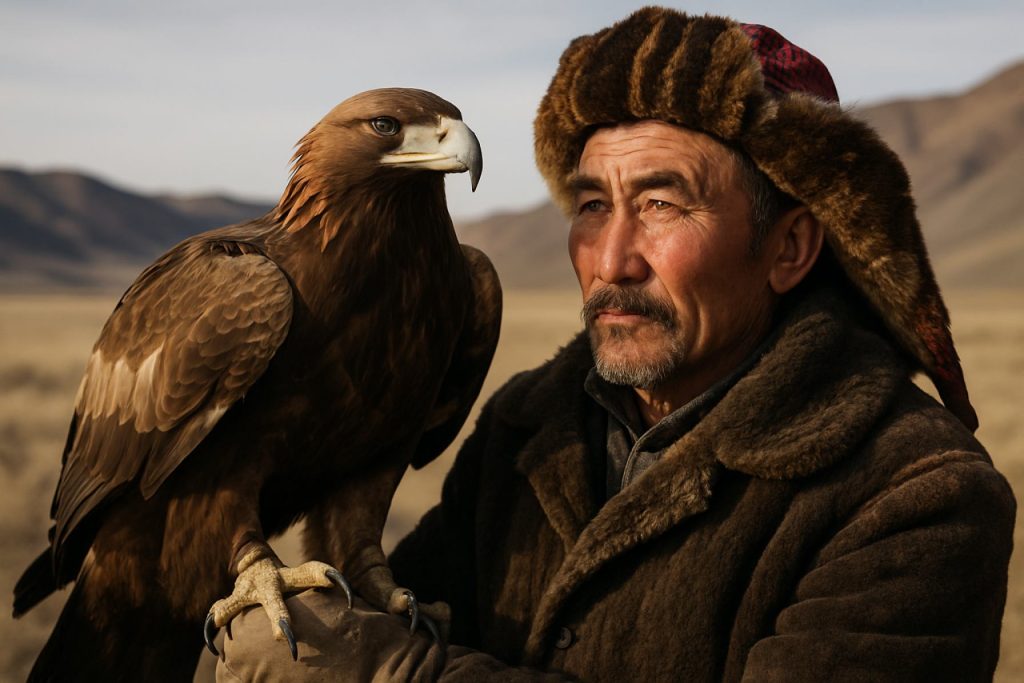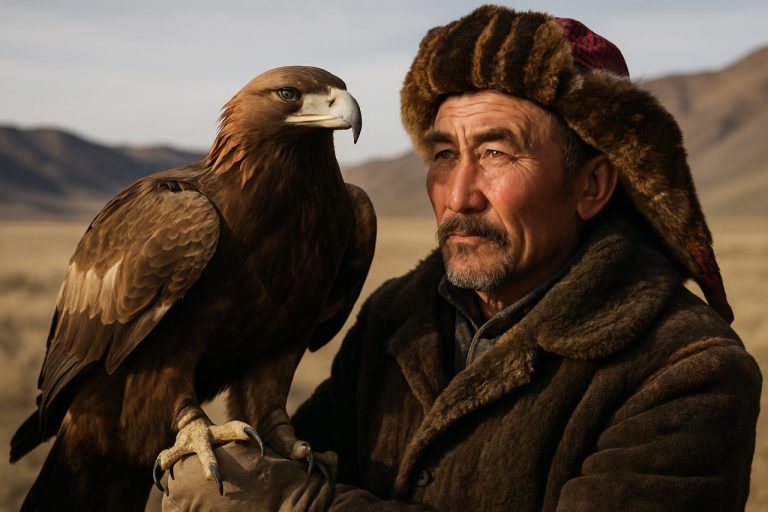
Inside the World of Kazakh Eagle Hunting Traditions: How Centuries-Old Skills, Culture, and Conservation Intertwine in the Steppes. Discover the Enduring Bond Between Hunters and Golden Eagles. (2025)
- Origins and Historical Evolution of Kazakh Eagle Hunting
- The Golden Eagle: Biology, Training, and Selection
- Traditional Equipment and Attire: Craftsmanship and Symbolism
- Rituals, Festivals, and Community Significance
- Role of Women and Changing Gender Dynamics
- Conservation Efforts and the Golden Eagle’s Status
- Modern Challenges: Urbanization, Legislation, and Cultural Shifts
- Technology’s Impact: GPS, Drones, and Digital Storytelling
- Global Recognition: UNESCO, Tourism, and International Festivals
- Future Outlook: Revival, Youth Engagement, and Predicted 30% Growth in Global Public Interest by 2030
- Sources & References
Origins and Historical Evolution of Kazakh Eagle Hunting
Kazakh eagle hunting, known locally as “berkutchi,” is a centuries-old tradition rooted in the nomadic cultures of Central Asia. The practice involves training golden eagles (Aquila chrysaetos) to hunt foxes, hares, and other small game, serving both as a means of subsistence and a symbol of status among Kazakh communities. Historical records and archaeological findings suggest that eagle hunting in the region dates back at least 2,000 years, with petroglyphs and artifacts depicting hunters with birds of prey found across the Altai Mountains and the Eurasian steppe.
The tradition flourished during the era of the Kazakh Khanate (15th–19th centuries), when berkutchi were highly respected and often served as advisors or warriors. The skills required for eagle hunting—patience, courage, and deep knowledge of the natural environment—became integral to Kazakh identity. The Soviet period (20th century) saw a decline in the practice due to collectivization and restrictions on nomadic lifestyles, but eagle hunting persisted in remote areas, particularly in western Mongolia and eastern Kazakhstan.
In recent decades, there has been a revival of interest in berkutchi culture, driven by efforts to preserve intangible cultural heritage. In 2010, UNESCO inscribed the “Traditional knowledge and skills in the art of eagle hunting” on its Representative List of the Intangible Cultural Heritage of Humanity, recognizing its significance and encouraging preservation initiatives. The UNESCO listing has spurred local and international support for festivals, training programs, and research projects aimed at sustaining the tradition.
As of 2025, eagle hunting remains most vibrant in the Bayan-Ölgii province of Mongolia, home to the largest community of Kazakh berkutchi, as well as in select regions of Kazakhstan. Annual events such as the Golden Eagle Festival attract participants and tourists, providing economic incentives for younger generations to learn the craft. Organizations like the UNESCO and national cultural ministries continue to collaborate on documentation, education, and sustainable tourism initiatives.
Looking ahead, the outlook for Kazakh eagle hunting traditions is cautiously optimistic. While modernization and urban migration pose challenges, ongoing cultural preservation efforts and growing global interest in indigenous practices are expected to support the transmission of berkutchi knowledge. The next few years will likely see increased integration of eagle hunting into cultural tourism and educational curricula, ensuring that this ancient art remains a living tradition for future generations.
The Golden Eagle: Biology, Training, and Selection
The golden eagle (Aquila chrysaetos) remains central to Kazakh eagle hunting traditions, a practice recognized by UNESCO as Intangible Cultural Heritage. In 2025, the biology, training, and selection of these raptors continue to reflect centuries-old expertise, while adapting to contemporary conservation and animal welfare standards.
Golden eagles are among the largest birds of prey, with wingspans reaching up to 2.3 meters and weights between 3 and 6.5 kilograms. Their keen eyesight and powerful talons make them ideal for hunting foxes, hares, and even wolves in the steppes and mountains of Kazakhstan. The selection process for hunting eagles, known locally as “berkut,” is highly specialized. Traditionally, Kazakh hunters, or “berkutchi,” prefer to capture female eagles, as they are larger and more aggressive than males. Juvenile birds, typically around four years old, are favored for their trainability and hunting potential.
Training begins with acclimatization, where the eagle is gradually introduced to human presence and the hunting environment. This process, which can last several months, involves feeding, gentle handling, and the use of traditional equipment such as the “tomaga” (hood) and “baldak” (perch). The bond between hunter and eagle is built on trust and mutual respect, with positive reinforcement techniques increasingly emphasized in recent years to align with modern animal welfare guidelines. Organizations such as the International Union for Conservation of Nature (IUCN) and local Kazakh conservation bodies have promoted best practices to ensure the well-being of both wild and captive eagles.
In 2025, the outlook for Kazakh eagle hunting traditions is shaped by both cultural revival and ecological awareness. Annual festivals, such as the National Golden Eagle Festival in Nura, continue to showcase the skills of berkutchi and their birds, attracting international attention and supporting rural economies. At the same time, there is growing collaboration with scientific organizations to monitor wild eagle populations and prevent overharvesting. The United Nations Environment Programme (UNEP) and Kazakh wildlife agencies are engaged in research and community outreach to balance tradition with species conservation.
Looking ahead, the integration of traditional knowledge with scientific management is expected to sustain the golden eagle’s role in Kazakh culture. Efforts to document and transmit training methods, alongside habitat protection initiatives, will be crucial in ensuring that the art of eagle hunting endures for future generations.
Traditional Equipment and Attire: Craftsmanship and Symbolism
In 2025, the traditional equipment and attire associated with Kazakh eagle hunting—known locally as berkutchi—continue to embody a rich blend of craftsmanship, symbolism, and cultural identity. The core equipment includes the tomaga (leather hood for the eagle), biyalai (thick glove), shyrga (lure), and the ayak bau (leather jesses). These items are typically handmade by skilled artisans, often using locally sourced leather, felt, and metal, and are decorated with intricate patterns that reflect regional Kazakh motifs and the hunter’s lineage.
The attire of the eagle hunter is equally significant. Traditional clothing consists of a fur-trimmed coat (ton), high leather boots, and a distinctive hat (tymak), often made from fox or wolf fur. These garments are not only practical—providing warmth and protection in the harsh steppe climate—but also serve as markers of status and heritage. Embroidery and ornamentation on the attire frequently incorporate symbols of strength, freedom, and the natural world, underscoring the spiritual connection between the hunter, the eagle, and the landscape.
Recent years have seen a renewed interest in preserving and revitalizing these artisanal traditions. In 2025, local cooperatives and cultural organizations in Kazakhstan are actively supporting master craftsmen through workshops, apprenticeships, and exhibitions. The Ministry of Culture and Sports of the Republic of Kazakhstan has played a pivotal role in promoting the transmission of these skills to younger generations, recognizing eagle hunting as an element of national intangible cultural heritage. This is further reinforced by the inclusion of Kazakh eagle hunting on the UNESCO Representative List of the Intangible Cultural Heritage of Humanity, which has spurred international interest and support for safeguarding traditional practices.
Looking ahead, the outlook for the preservation of traditional equipment and attire is cautiously optimistic. While modernization and the availability of mass-produced materials pose challenges, there is a growing market for authentic, handcrafted items among both practitioners and cultural tourists. Initiatives to document and teach traditional techniques are expected to expand in the coming years, supported by government funding and international collaboration. As a result, the unique craftsmanship and symbolism embedded in Kazakh eagle hunting traditions are likely to remain vibrant, serving as a living testament to the enduring cultural legacy of the Kazakh people.
Rituals, Festivals, and Community Significance
Kazakh eagle hunting, known as “berkutchi,” remains a vibrant cultural tradition in Kazakhstan and western Mongolia, with its rituals and festivals playing a central role in community life. In 2025, these practices continue to be celebrated and adapted, reflecting both deep-rooted heritage and contemporary cultural dynamics.
The most prominent event is the annual Golden Eagle Festival, held in Bayan-Ölgii province, Mongolia, and increasingly in Kazakhstan’s Almaty and East Kazakhstan regions. These festivals, typically occurring in October, gather dozens of eagle hunters (berkutchi) who demonstrate their skills in hunting, horsemanship, and traditional attire. The events attract thousands of local and international visitors, serving as a platform for cultural exchange and economic opportunity for rural communities. The UNESCO recognition of eagle hunting as Intangible Cultural Heritage in 2010 has further elevated the profile of these festivals, encouraging preservation efforts and international interest.
Rituals associated with eagle hunting remain integral to the tradition. The process of capturing a young eagle, training it over several years, and eventually releasing it back into the wild is imbued with ceremonial practices. These include blessings by elders, offerings to the spirits of the mountains, and communal feasts. In 2025, there is a renewed emphasis on these rituals, as local organizations and cultural custodians seek to reinforce the spiritual and ethical dimensions of berkutchi in the face of modernization and tourism-driven commercialization.
Community significance is evident in the way eagle hunting fosters intergenerational bonds and social cohesion. Young apprentices learn from experienced hunters, ensuring the transmission of knowledge and values. Women’s participation, once rare, is gradually increasing, with several female berkutchi gaining recognition at recent festivals. This shift reflects broader societal changes and efforts to make the tradition more inclusive.
Looking ahead, the outlook for Kazakh eagle hunting traditions is cautiously optimistic. Governmental and non-governmental organizations in Kazakhstan and Mongolia are collaborating to support sustainable tourism, wildlife conservation, and cultural education. The UNESCO designation continues to provide a framework for safeguarding intangible heritage, while local communities adapt rituals and festivals to contemporary realities. Challenges remain, including habitat loss for golden eagles and the pressures of commercialization, but the resilience and adaptability of the berkutchi community suggest that these traditions will endure and evolve in the coming years.
Role of Women and Changing Gender Dynamics
Kazakh eagle hunting, or berkutchi, has historically been a male-dominated tradition, with skills and knowledge passed from father to son across generations. However, the role of women in this ancient practice is undergoing significant transformation in 2025 and is expected to continue evolving in the coming years. This shift is influenced by broader social changes in Kazakhstan and Mongolia, where most Kazakh eagle hunters reside, as well as by international attention and local initiatives aimed at gender inclusivity.
In recent years, women have increasingly participated in eagle hunting festivals and competitions, most notably the annual Golden Eagle Festival in Bayan-Ölgii, Mongolia. The festival, organized by the local Kazakh community, has seen a growing number of female competitors, with young women such as Aisholpan Nurgaiv gaining international recognition for their skills. Aisholpan’s story, documented in the film “The Eagle Huntress,” has inspired a new generation of girls to pursue eagle hunting, challenging traditional gender roles and expectations.
Organizations such as the United Nations Educational, Scientific and Cultural Organization (UNESCO) have recognized the cultural significance of Kazakh eagle hunting, inscribing it on the Representative List of the Intangible Cultural Heritage of Humanity. UNESCO’s support has encouraged local communities to preserve the tradition while promoting gender equality and youth involvement. In 2025, local NGOs and cultural associations in Kazakhstan and Mongolia are actively supporting training programs and workshops for women and girls interested in eagle hunting, aiming to ensure the tradition’s sustainability and inclusivity.
Data from recent festival participation and community surveys indicate a steady increase in female eagle hunters, though they still represent a minority. For example, in the 2024 Golden Eagle Festival, women accounted for approximately 10% of competitors, a figure expected to rise as social attitudes continue to shift and as more role models emerge. The Kazakh government and regional authorities have also expressed support for women’s participation, viewing it as a means to promote cultural heritage and rural tourism.
Looking ahead, the outlook for women in Kazakh eagle hunting is positive. Continued advocacy, international recognition, and local empowerment initiatives are likely to further erode gender barriers. As more women take up the practice, they are not only preserving a unique cultural tradition but also redefining its social meaning for future generations.
Conservation Efforts and the Golden Eagle’s Status
Kazakh eagle hunting, or berkutchi, is deeply intertwined with the conservation status of the golden eagle (Aquila chrysaetos). As of 2025, the golden eagle remains classified as “Least Concern” globally by the International Union for Conservation of Nature (IUCN), but regional populations in Central Asia face mounting pressures. Habitat loss, illegal poaching, and declining prey species are ongoing threats, prompting both governmental and non-governmental organizations to intensify conservation efforts.
In Kazakhstan, the Ministry of Ecology and Natural Resources oversees wildlife protection and has implemented stricter regulations on eagle capture and training. Only licensed berkutchi are permitted to take young eagles from the wild, and the number of birds that can be captured annually is tightly controlled. These measures are designed to ensure that traditional practices do not negatively impact wild populations. The United Nations Educational, Scientific and Cultural Organization (UNESCO) has also recognized Kazakh eagle hunting as Intangible Cultural Heritage, which has increased international attention and support for sustainable practices.
Recent years have seen collaborative research projects between Kazakh institutions and international partners, such as the BirdLife International network, focusing on population monitoring and habitat preservation. Satellite tracking of released eagles, initiated in 2023, continues to provide valuable data on migration patterns and survival rates, informing adaptive management strategies.
Looking ahead to the next few years, conservationists are prioritizing community engagement and education. Local berkutchi associations are working with schools and youth groups to foster appreciation for both the cultural and ecological importance of golden eagles. Eco-tourism initiatives, supported by the World Tourism Organization (UNWTO), are being developed to provide alternative income sources for rural communities, reducing reliance on unsustainable hunting or wildlife trade.
- Continued enforcement of capture quotas and licensing by Kazakh authorities.
- Expansion of eagle monitoring programs using advanced tracking technologies.
- Increased international cooperation for habitat conservation and research.
- Integration of conservation education into local and national curricula.
The outlook for the golden eagle in Kazakhstan is cautiously optimistic. While challenges remain, the synergy between traditional knowledge and modern conservation science offers a promising path for sustaining both the species and the centuries-old practice of eagle hunting.
Modern Challenges: Urbanization, Legislation, and Cultural Shifts
Kazakh eagle hunting, or berkutchi, faces significant challenges in 2025 as Kazakhstan continues to urbanize and modernize. The migration of younger generations to cities has led to a decline in the number of active eagle hunters, with estimates suggesting that fewer than 100 traditional practitioners remain in the country. This demographic shift threatens the intergenerational transmission of skills and knowledge, as the apprenticeship model—central to the tradition—relies on close, long-term mentorship in rural settings.
Legislation also plays a complex role. While Kazakhstan recognizes eagle hunting as an element of its intangible cultural heritage, and it is inscribed on the UNESCO Representative List of the Intangible Cultural Heritage of Humanity, regulatory frameworks for wildlife protection and animal welfare are evolving. Newer laws aimed at protecting raptors and regulating hunting practices sometimes create bureaucratic hurdles for traditional hunters, who must now navigate licensing systems and restrictions on capturing wild eagles. The United Nations Educational, Scientific and Cultural Organization (UNESCO) continues to monitor and support safeguarding measures, but balancing conservation with cultural practice remains a delicate issue.
Cultural shifts are also evident. As Kazakhstan’s economy diversifies and lifestyles change, younger Kazakhs are less likely to view eagle hunting as a viable livelihood or status symbol. Instead, the tradition is increasingly showcased at festivals and tourism events, such as the annual Golden Eagle Festival in the Almaty region. While these events raise awareness and generate income, some practitioners express concern that the performative aspect may dilute the tradition’s authenticity and spiritual significance.
Looking ahead, the outlook for Kazakh eagle hunting traditions is mixed. On one hand, government and non-governmental organizations are investing in cultural preservation programs, educational workshops, and rural development initiatives to support practitioners. On the other, ongoing urbanization and shifting values may further erode the tradition’s social base. International recognition, such as that from UNESCO, provides a platform for advocacy and funding, but the sustainability of eagle hunting as a living tradition will depend on adaptive strategies that reconcile heritage with contemporary realities.
- Urbanization is reducing the number of active eagle hunters.
- Legislation is both protecting raptors and complicating traditional practices.
- Cultural shifts are moving the tradition from daily life to staged events.
- Preservation efforts are underway, but long-term viability remains uncertain.
Technology’s Impact: GPS, Drones, and Digital Storytelling
Kazakh eagle hunting, a centuries-old tradition practiced primarily in the Altai Mountains of western Mongolia and parts of Kazakhstan, is experiencing a technological transformation in 2025. The integration of GPS tracking, drone technology, and digital storytelling platforms is reshaping how this cultural heritage is preserved, practiced, and shared with the world.
One of the most significant advancements is the adoption of GPS tracking devices for both eagles and hunters. These devices allow hunters to monitor the movements and health of their birds with unprecedented precision. By analyzing GPS data, hunters can optimize training regimens, track migration patterns, and ensure the safety of their eagles during hunts. This technology also aids in scientific research, providing valuable data on the behavior and range of golden eagles in the region. Organizations such as the International Union for Conservation of Nature (IUCN) have highlighted the importance of such data in conservation efforts, as it helps monitor eagle populations and their habitats.
Drones are increasingly being used to document and support eagle hunting activities. In 2025, lightweight drones equipped with high-resolution cameras are capturing aerial footage of hunts, offering new perspectives for both practitioners and audiences. These drones assist in scouting terrain, locating prey, and ensuring the safety of hunters in remote and rugged landscapes. The use of drones is also facilitating research collaborations with wildlife organizations, enabling the collection of environmental data without disturbing the natural behavior of eagles or their prey.
Digital storytelling platforms are playing a crucial role in the preservation and dissemination of Kazakh eagle hunting traditions. Social media, virtual reality experiences, and online documentaries are making the practice accessible to global audiences. Initiatives supported by organizations like UNESCO, which has recognized Kazakh eagle hunting as Intangible Cultural Heritage, are leveraging digital media to document oral histories, training methods, and the personal stories of hunters. These efforts not only raise awareness but also attract younger generations to the tradition, ensuring its continuity.
Looking ahead, the convergence of technology and tradition is expected to deepen. As connectivity improves in rural Mongolia and Kazakhstan, more hunters are likely to adopt digital tools for training, safety, and storytelling. This technological embrace, balanced with respect for ancestral knowledge, is poised to sustain and revitalize Kazakh eagle hunting for years to come.
Global Recognition: UNESCO, Tourism, and International Festivals
Kazakh eagle hunting traditions, known locally as “bürkitshi,” have gained significant global recognition in recent years, particularly following their inscription on the UNESCO Representative List of the Intangible Cultural Heritage of Humanity in 2010. This acknowledgment by UNESCO, a specialized agency of the United Nations dedicated to education, science, and culture, has played a pivotal role in elevating the profile of eagle hunting both within Kazakhstan and internationally. As of 2025, this status continues to foster cultural pride and international interest, encouraging preservation efforts and cross-cultural exchange.
Tourism centered around eagle hunting is expected to see steady growth through 2025 and beyond. The annual Golden Eagle Festival, held in Mongolia’s Bayan-Ölgii province and increasingly in Kazakhstan’s Almaty and East Kazakhstan regions, attracts thousands of visitors from around the world. These festivals showcase the skills of eagle hunters, traditional Kazakh attire, and horsemanship, providing immersive experiences for tourists. According to the Kazakhstan National Tourism Board, the number of international visitors attending eagle hunting events has risen annually, with projections for 2025 indicating further increases as travel recovers post-pandemic and as Kazakhstan continues to promote its cultural heritage as a cornerstone of its tourism strategy.
- In 2023, the Golden Eagle Festival in Kazakhstan reported over 5,000 international attendees, a figure expected to surpass 6,000 in 2025, reflecting growing global fascination with the tradition (Kazakhstan National Tourism Board).
- The UNESCO listing has encouraged local and national governments to invest in infrastructure and training for eagle hunters, ensuring the transmission of knowledge to younger generations and the sustainability of the practice.
- International collaborations, such as cultural exchange programs and documentary projects, are on the rise, with organizations like UNESCO and the Kazakhstan National Tourism Board supporting initiatives that bring eagle hunters to global festivals and conferences.
Looking ahead, the outlook for Kazakh eagle hunting traditions is positive. The synergy between UNESCO recognition, expanding tourism, and international festival participation is expected to further solidify the tradition’s global standing. Continued support from official bodies and increased international awareness are likely to ensure that eagle hunting remains a vibrant and celebrated aspect of Kazakh cultural heritage well into the future.
Future Outlook: Revival, Youth Engagement, and Predicted 30% Growth in Global Public Interest by 2030
Kazakh eagle hunting traditions, known as “berkutchi,” are experiencing a notable revival in the 2020s, with projections indicating a significant increase in global public interest by 2030. This resurgence is driven by a combination of cultural preservation efforts, youth engagement initiatives, and international recognition of the practice as an intangible cultural heritage.
In 2025, the tradition continues to be celebrated at major events such as the annual Golden Eagle Festival in Bayan-Ölgii, Mongolia, which attracts hundreds of eagle hunters and thousands of visitors from around the world. The festival serves as a focal point for cultural exchange and education, with participation from both Kazakh and international youth. The UNESCO designation of Kazakh eagle hunting as Intangible Cultural Heritage in 2010 has further elevated its profile, encouraging local and national governments in Kazakhstan and Mongolia to invest in preservation and promotion programs.
Youth engagement is a central pillar of the tradition’s revival. In recent years, there has been a marked increase in the number of young apprentices, including girls, learning the art of eagle hunting. Educational initiatives, often supported by local cultural organizations and schools, provide training in traditional skills, falconry ethics, and environmental stewardship. The UNESCO Intangible Cultural Heritage Lists highlight the importance of intergenerational transmission, and local authorities have responded by integrating eagle hunting into school curricula and extracurricular activities.
Looking ahead, experts predict a 30% growth in global public interest in Kazakh eagle hunting traditions by 2030. This projection is based on rising international tourism to Central Asia, increased media coverage, and the proliferation of documentaries and digital content showcasing the practice. The Kazakhstan National Tourism Board and similar organizations in Mongolia are actively promoting eagle hunting festivals and experiences as key attractions, targeting eco-tourists and cultural enthusiasts.
- Continued support from international bodies such as UNESCO is expected to bolster funding and awareness campaigns.
- Local governments are expanding infrastructure and training programs to accommodate growing interest and ensure the sustainability of the tradition.
- Collaborations with wildlife conservation groups are being strengthened to address ecological concerns and promote ethical falconry practices.
In summary, the future outlook for Kazakh eagle hunting traditions is optimistic, with robust youth engagement and institutional support laying the groundwork for sustained growth in global recognition and participation through 2030 and beyond.
Sources & References
- UNESCO
- UNESCO
- International Union for Conservation of Nature
- United Nations Educational, Scientific and Cultural Organization
- BirdLife International
- World Tourism Organization
- UNESCO
- Kazakhstan National Tourism Board



